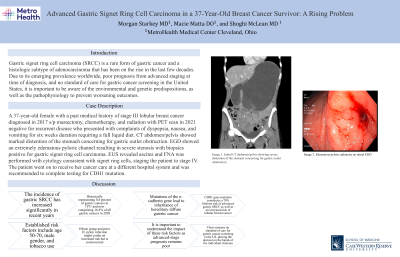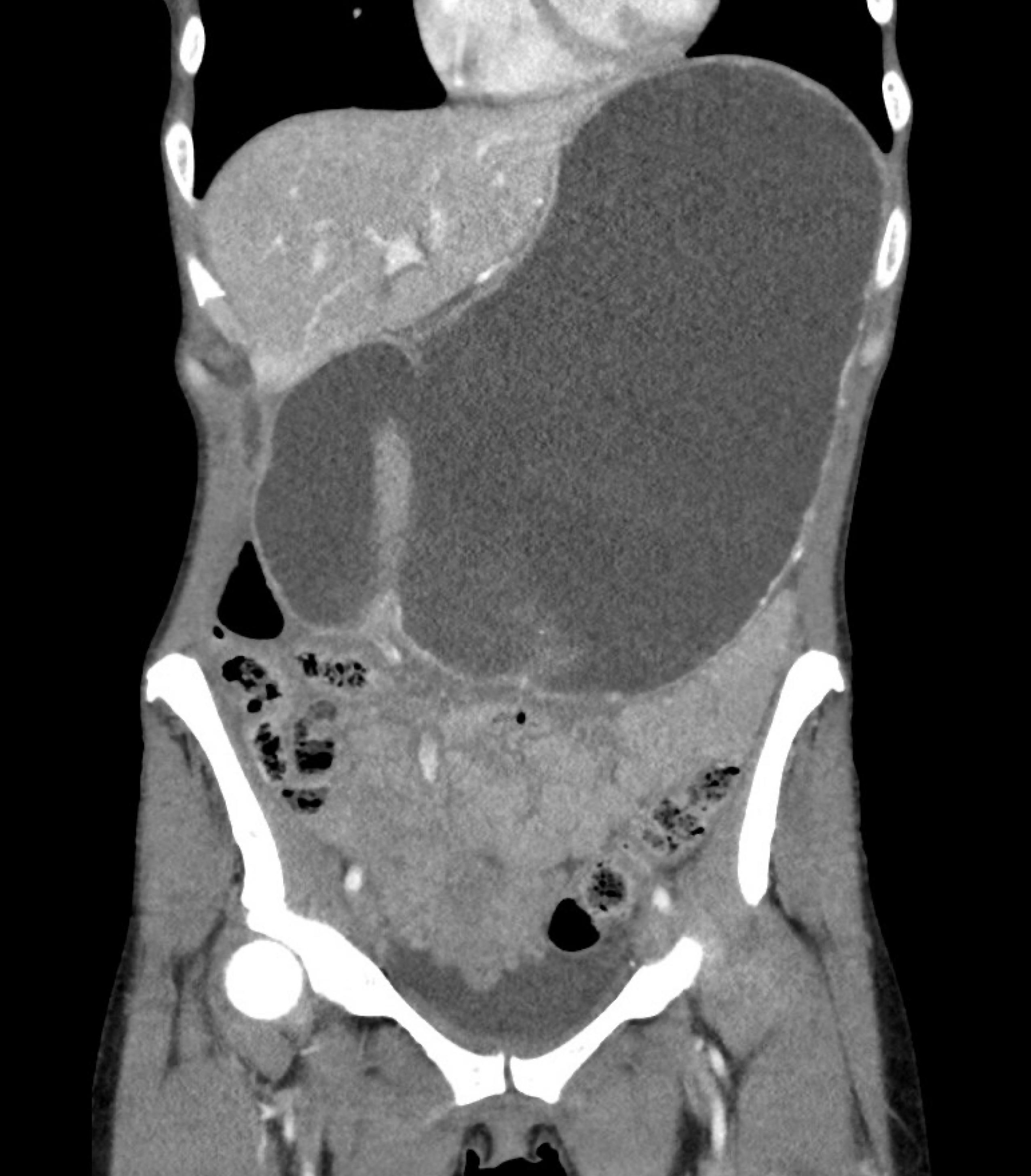Monday Poster Session
Category: Stomach
P2798 - Advanced Gastric Signet Ring Cell Carcinoma in a 37-Year-Old Breast Cancer Survivor: A Rising Problem
Monday, October 23, 2023
10:30 AM - 4:15 PM PT
Location: Exhibit Hall

Has Audio

Morgan R. Starkey, MD
MetroHealth Medical Center
Cleveland, OH
Presenting Author(s)
Morgan R. Starkey, MD, Macie Matta, DO, Shoghi McLean, MD
MetroHealth Medical Center, Cleveland, OH
Introduction: Gastric signet ring cell carcinoma (SRCC) is a rare form of gastric cancer and a histologic subtype of adenocarcinoma that has been on the rise in the last few decades. Due to its emerging prevalence worldwide, poor prognosis from advanced staging at time of diagnosis, and no standard of care for gastric cancer screening in the United States, it is important to be aware of the environmental and genetic predispositions, as well as the pathophysiology to prevent worsening outcomes.
Case Description/Methods: A 37-year-old female with a past medical history of stage III lobular breast cancer diagnosed in 2017 s/p mastectomy, chemotherapy, and radiation with PET scan in 2021 negative for recurrent disease who presented with complaints of dyspepsia, nausea, and vomiting for six weeks duration requiring a full liquid diet. CT abdomen/pelvis showed marked distention of the stomach concerning for gastric outlet obstruction. EGD showed an extremely edematous pyloric channel resulting in severe stenosis with biopsies positive for gastric signet ring cell carcinoma. EUS revealed ascites and FNA was performed with cytology consistent with signet ring cells, staging the patient to stage IV. The patient went on to receive her cancer care at a different hospital system and was recommended to complete testing for CDH1 mutation.
Discussion: Historically gastric SRCC was less common than non-SRCC, making up approximately 0.8% of gastric cancers in the United States in 1971. Since then, the incidence of SRCC has increased from 0.1 to 1.4 cases per 100,000 people from 1973-2004, now comprising around 16.8% of all gastric cancers in 2020. Advanced age between 50-70 years, male gender, and smoking are established risk factors for the development of gastric SRCC, while ethnic distribution and h. pylori infection remains controversial. Most importantly mutations of the e-cadherin gene CDH1 leads to the inheritance of hereditary diffuse gastric cancer (HDGC) that poses a 70% lifetime risk of advanced gastric SRCC and elevated risk of lobular breast cancer as seen in our patient. It is important to understand the impact of these risk factors as advanced-stage prognosis remains poor and there remains no standard of care for gastric cancer screening in the United States, placing the decision in the hands of the individual clinician.

Disclosures:
Morgan R. Starkey, MD, Macie Matta, DO, Shoghi McLean, MD. P2798 - Advanced Gastric Signet Ring Cell Carcinoma in a 37-Year-Old Breast Cancer Survivor: A Rising Problem, ACG 2023 Annual Scientific Meeting Abstracts. Vancouver, BC, Canada: American College of Gastroenterology.
MetroHealth Medical Center, Cleveland, OH
Introduction: Gastric signet ring cell carcinoma (SRCC) is a rare form of gastric cancer and a histologic subtype of adenocarcinoma that has been on the rise in the last few decades. Due to its emerging prevalence worldwide, poor prognosis from advanced staging at time of diagnosis, and no standard of care for gastric cancer screening in the United States, it is important to be aware of the environmental and genetic predispositions, as well as the pathophysiology to prevent worsening outcomes.
Case Description/Methods: A 37-year-old female with a past medical history of stage III lobular breast cancer diagnosed in 2017 s/p mastectomy, chemotherapy, and radiation with PET scan in 2021 negative for recurrent disease who presented with complaints of dyspepsia, nausea, and vomiting for six weeks duration requiring a full liquid diet. CT abdomen/pelvis showed marked distention of the stomach concerning for gastric outlet obstruction. EGD showed an extremely edematous pyloric channel resulting in severe stenosis with biopsies positive for gastric signet ring cell carcinoma. EUS revealed ascites and FNA was performed with cytology consistent with signet ring cells, staging the patient to stage IV. The patient went on to receive her cancer care at a different hospital system and was recommended to complete testing for CDH1 mutation.
Discussion: Historically gastric SRCC was less common than non-SRCC, making up approximately 0.8% of gastric cancers in the United States in 1971. Since then, the incidence of SRCC has increased from 0.1 to 1.4 cases per 100,000 people from 1973-2004, now comprising around 16.8% of all gastric cancers in 2020. Advanced age between 50-70 years, male gender, and smoking are established risk factors for the development of gastric SRCC, while ethnic distribution and h. pylori infection remains controversial. Most importantly mutations of the e-cadherin gene CDH1 leads to the inheritance of hereditary diffuse gastric cancer (HDGC) that poses a 70% lifetime risk of advanced gastric SRCC and elevated risk of lobular breast cancer as seen in our patient. It is important to understand the impact of these risk factors as advanced-stage prognosis remains poor and there remains no standard of care for gastric cancer screening in the United States, placing the decision in the hands of the individual clinician.

Figure: Initial CT abdomen/pelvis showing severe distention of the stomach concerning for gastric outlet obstruction
Disclosures:
Morgan Starkey indicated no relevant financial relationships.
Macie Matta indicated no relevant financial relationships.
Shoghi McLean indicated no relevant financial relationships.
Morgan R. Starkey, MD, Macie Matta, DO, Shoghi McLean, MD. P2798 - Advanced Gastric Signet Ring Cell Carcinoma in a 37-Year-Old Breast Cancer Survivor: A Rising Problem, ACG 2023 Annual Scientific Meeting Abstracts. Vancouver, BC, Canada: American College of Gastroenterology.
